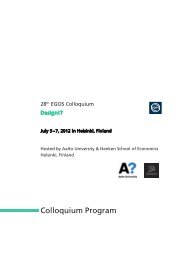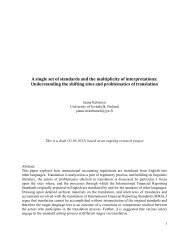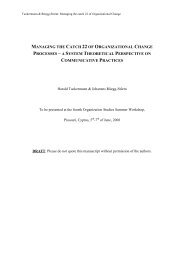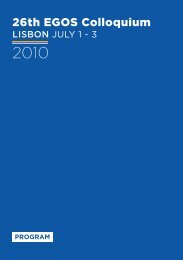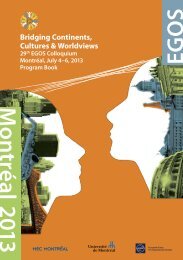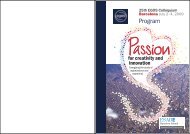Download Full Paper - EGOS
Download Full Paper - EGOS
Download Full Paper - EGOS
Create successful ePaper yourself
Turn your PDF publications into a flip-book with our unique Google optimized e-Paper software.
While looking at the standard mediators of the case organization and their institutionalization<br />
in roles and organizational sub-units, researchers of technology-use can also draw conclusions<br />
from the alignment research stream where “the question of stability and change in role<br />
relationships” is investigated and therefore “the use of a technology might alter or confirm an<br />
existing social order” (Leonardi & Barley 2010, p.25). The alignment to the new standards in<br />
our case company led to the creation of new roles and a whole new department. As we found<br />
out, standard-mediators stand for the transition from enactment to alignment. In the beginning<br />
they were simple but already experienced users and therefore enacted an implicit structuring<br />
process. The transition from implicit to explicit structuring was accomplished when these<br />
users were selected to exercise the new role as standard-mediators. This argumentation is<br />
supported by the findings of Yates et al. (1999) on implicit and explicit structuring of<br />
mediators of an electronic communication media.<br />
Another correlation can be found while observing the different development steps from<br />
implicit structuring, to first a small project and finally a process group while dealing first only<br />
with CMMI in a single organizational unit and then expanding the responsibilities over to<br />
other standards and other organizational units and in the end the whole organization.<br />
Orlikowski (1996) and Leonardi (2007) described these steps as “a phased sequence of<br />
emergent and cumulative changes” (Leonardi & Barley 2010, p.28) and by that emphasized<br />
the relationship between enactment and alignment. We fully support this description and<br />
showed evidence for the 'world of standards' with our findings.<br />
However, whether a standard is experienced as coercive or enabling depends on various<br />
contextual factors like, for instance, support-giving or support-providing norms, the self-<br />
conception of mediators, the concrete interpretation of a standard or, as shown in another<br />
study, the appropriation of standards (Gey 2011). The same line of thought can be applied to<br />
the experience of the whole standard landscape within an organization or experiences with the<br />
standard script as the organization-wide process reference and outcome of the standard-<br />
mediation. At A-Suppliers the support from the higher management as well as from the board<br />
<strong>Full</strong> paper GEY & FRIED <strong>EGOS</strong> conference 2012, Sub-theme 15 19



